Sue Kaufman, a 20-year veteran of the business world, volunteers with several environmental organizations. She is soon to join Grist‘s board of directors. Here she chronicles her volunteer activities on a recent expedition with Earthwatch Institute to the Peruvian Amazon..

Monday, 1 Mar 2004
LIMA, Peru
Greetings from Lima, Peru, where I am spending the night before heading out to Puerto Maldonado and up the Tambopata River. After many weeks of anticipation, I am thrilled and awed to find myself heading into the Amazon — and thankful to Earthwatch Institute for giving me the opportunity to fulfill a personal fantasy.
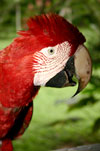
Macaw of the wild.
Photo: Christopher Jonas.
As many of you may know, Earthwatch funds scientific field research focused on a sustainable environment and provides volunteers the opportunity to participate in that research, as a way to learn more about what will be required to sustain the environment. This I learned one day last November when I picked up their catalog in my local natural-foods store. There were trips all over the world, everywhere from the Arctic to coral reefs, but the trip I have chosen is called “Macaws of the Peruvian Amazon.”
Why, you might ask (I’m asking myself to some extent), would I pick a place that requires multiple immunizations and a backpack full of mosquito netting shaped into various forms of clothing, for which your friends’ parting comment is not “Have a great trip,” but a bemused “Be careful”? Ever since I spent several weeks in the rain and cloud forests of Costa Rica, I have wanted to spend time in the Amazon — and here I am, on my way.
The Peruvian Amazon, I was both gladdened and saddened to learn, contains some of the only regions of the Amazon so unspoiled that it is relatively easy to see wildlife of all kinds. I was also somewhat saddened to learn that I was going in the middle of the rainy season.
Why macaws, you might also ask? I was primarily motivated by my fantasies of becoming an ornithologist in my next life. And macaws are large, I figured. Even I — amateur birder that I am, with eyes that aren’t what they used to be — would be able to see them.
As I began reading about macaws and the parrot family to which they belong, I learned that they are an important group for study. On the one hand, they are one of the most imperiled families of birds, with the multiple threats of habitat destruction, hunting, and capture for the bird trade. It has been estimated that somewhere between 6 and 10 percent of U.S. households have a pet tropical bird. In the years 1982 to 1988, it was estimated that 1.8 million birds in the parrot family were imported into the U.S. Although their import has since been outlawed in the U.S., illegal trade to the U.S. continues, as does trade with other countries, particularly in Asia. As a result, parrots have the most endangered species of any family of birds.
On the other hand, they are generally ignored by ornithologists; as one parrot specialist noted, most ornithologists think their natural habitat is the cage. He went on to note, “Most ornithologists and ecologists today are nearly completely ignorant of the biology of these birds and the extent of their conservation problems. There have been so few detailed studies of psittacines in the wild that parrot biology could be considered one of the present ‘frontiers’ of ornithology.” All of this has begun to make me feel that I will be doing important work here in the Amazon.
It turns out that the research team I will be joining (with 12 other Earthwatch volunteers) at the Tombopata Research Center in southern Peru has been gathering data on macaws for more than a decade. Their data comprises one of the most complete data sets on parrots in the wild in existence. And most interesting to me, their research has been conducted in partnership with the native community on the Tombopata, which runs an ecotourist lodge where I’ll be tomorrow night. Macaws have been identified as having major ecotourist value: They are large and bright, so even a gringo unschooled in the rainforest can spot them, and they hang out in predictable locations — clay licks. I’ll describe a clay lick later this week as I write about our work as volunteers at Tombopata Research Center.
For the next four days, I’ll fill you in on the life of an Earthwatch volunteer in the Amazon. Now, as I sit here in my hotel in Lima, I find myself with a few large questions about what I’ll be doing:
- How will learning about macaws lead to preservation of the Amazon?
- How does a partnership with the native population engaged in saving endangered species and habitat look?
- Do I really like spending six to eight hours a day collecting data on birds’ comings and goings?
I hope I’ll be able to gain some insights — for myself, as well as for you. Stay tuned.
Tuesday, 2 Mar 2004
PUERTO MALDONADO, Peru
Yesterday afternoon, after climbing a 35-meter tower into the canopy of the Amazon rainforest, I really knew I had arrived. We looked down on the winding Tambopata River and watched parrots and parakeets fly by at eye level. We also saw our first glorious glimpse of two of the three macaw species that will be our focus for the next 12 days. Hans, our guide, was careful to distinguish their raucous calls: “You’ll need to know this.”
Hans and our other guide, Sophia, had met us at the airport in Puerto Maldonado, a town of 40,000 and the entry point for the Tambopata River. We bounced out of town in a thatch-roofed bus while the guides produced tasty local snacks — plantain chips and locally bottled juice from a Brazilian fruit, copazua. So far, so good! From the bus, we got on a boat for the two-hour trip upriver to Posada Amazonas, our first destination.
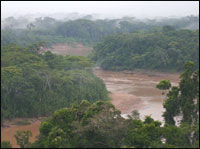
The Tambopata River.
Photo: Christopher Jonas.
This morning I continued my short stint as an ecotourist before our macaw work began. Posada Amazonas may be the quintessential ecotourist experience. Start with the fact that we are in the area of greatest biodiversity of the Amazon basin, which is one of the areas of highest biodiversity in the world. Posada Amazonas is owned jointly by the native Ese-eja community and Rainforest Expeditions (and at the end of 20 years, ownership will transfer 100 percent to the community). The jobs and profits that ecotourism provides to the local community are helping change attitudes toward land use on the 25,000-acre reserve where it is located. The open, airy rooms (with one wall open to the rainforest), the delicious food from locally grown ingredients, and the high-quality service make the experience as a guest a delightful one. At the same time, we are all stewards of the rainforest, using only the biodegradable shampoo provided and reading by kerosene lanterns and candles.
We — myself and two other Earthwatch volunteers, Tanya and Rhonda — were up early this morning for a 5:30 departure to a nearby oxbow lake where we hoped to see, among other things, giant river otters. Hans, who is from the cloud forest of Peru and studied tourism in college in Lima, wakes us. He’ll be with us throughout our stay here, rather like our personal camp counselor — combining his significant knowledge of the rainforest with concern for our well-being. He’ll accompany the Earthwatch group to the Tambopata Research Center as well.
We didn’t see the river otters — and it seemed OK that they did not perform on command, especially because we had a much more real wildlife experience as we were walking in to the lake. Suddenly, Christian, the Posada employee who’d come along to help with the boat and lead the procession, came running back with eyes like saucers. As we rounded the bend, we saw the middle section of a four-meter anaconda crossing the trail. His belly was about 12 inches in diameter and it was clear from his lethargic pace that he had just ingested an agouti or some other significant mammal.
You know it’s an unusual sighting when even your guide and a local look shocked. It was the talk of the lodge as all of the staff pored over the minute image on Tanya’s digital camera. It was also the substance of our introductory conversation with Donald Brightsmith, the principal investigator for the Earthwatch research, who’d just arrived from Tambopata Research Center to train us up.
The better part of the rest of the day was spent learning how to record the data we will be gathering and filling them in from written examples and tests. But first, we had the “Earthwatch-required” speech about the various hazards we’d face: the river (it gets wilder from here), dehydration (drink constantly and check the color of your pee), insect-borne diseases (Leishmaniasis isn’t fun and the treatment is worse, so tuck in your trousers and shirts). How about poisonous snakes, someone asks — visions of fer-de-lances slithering in all our heads. Not to worry, Donald assures us. “They are pretty low density.” Based on the events of my day, not reassuring!
Wednesday, 3 Mar 2004
PUERTO MALDONADO, Peru
Today we began work.
We’ve come five hours upriver to the Tambopata Research Center. At 4:30 a.m., our guides (still our camp counselors) wake us and we stumble through the dark into our uniform of long-sleeve shirts, long pants tucked into our socks, and tall rubber boots. We grab a Tupperware of breakfast and head out. My partner, Tanya, and I have the most high-pressure job: early morning at the clay lick.
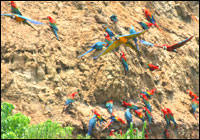
Macaws visit the clay lick.
Photo: Anne Dickens.
The clay lick is about a quarter mile of riverbank with 100 feet of vertical red clay. Actually, although it looks like all red clay, binoculars reveal a variety of colors that, on analysis, have proved to have different mineral and clay contents. The lick is visited by up to 15 species of birds, including our three large macaws, scarlet, red and green, and blue and yellow. They visit for reasons that are not completely understood but are of great interest to Donald Brightsmith, our principal investigator.
Although clay licks occur throughout the Amazon, this may be the largest, with the most species visiting. And Brightsmith has the largest dataset of clay-lick observations — more than 300,000 data points. Brightsmith is working with a couple of theories as to why parrots and macaws spend time here. Primarily seed eaters, parrots ingest many toxins that the seeds have evolved to preserve them from this very predation. It is thought that the clay in the lick may neutralize these toxins. At the same time, their diet is low in sodium and Brightsmith has found that the birds’ favorite parts of the lick are high in that very mineral.
In addition to the insights it provides into the diet and natural history of the birds, the clay-lick research is of importance to ecotourism in the area. It is in many ways ideal for ecotourism. It is relatively predictable, and the birds are spectacular and easy to see. Hence, it represents a significant source of revenue for the area. A large percentage of tourists to the area list macaws as among their reasons to travel here. The research we are aiding will help determine the impact of tourists and other boat traffic (though the word traffic is an exaggeration in this remote spot). This is very germane to the local community, which wants to ensure that it doesn’t kill the golden goose, so to speak.
Today, about a dozen species of birds arrive, gather in nearby trees, vocalize loudly, circle the lick (“the dance”), and dare each other to be the first to land. Once one bird goes down to the lick — today and many days it is a red-bellied macaw — it is followed by dozens of others: 150 mealy parrots, five blue-headed parrots, and finally a group of larger macaws, the red and green. After a while, they are all flushed by an unknown cause and the ritual begins again, with different species coming and going. For those whose idea of an ecotourism event includes days of plane flights, six to seven hours on a riverboat into the jungle, and getting up at 4:30 a.m., it is a spectacular sight.
But for us it is all business. Although Aida, the manager of the project for the last year, will identify birds and do the count for the initial busy period, it is our job to record … everything. The first call, the arrival of each species, the departure of our boat, the random boat with a tourist (“Where did that boat come from?” Brightsmith wondered at lunch; not much comes down this way that he doesn’t recognize), and, every five minutes, the number of birds, by species, on the lick, and the weather — all go somewhere on the data sheet.
In the written example it all seemed clear, but things are moving rapidly here in the field. “First call, red-bellied macaw,” Aida says, in her calm and subdued way. “The blue-headed parrots arrive.” “Did you get the departure of the boat?” “Mealy parrots.” Frantically, I search the data sheet for the seemingly random place to record these events. Meanwhile, somehow I keep screwing up the digital watch that is supposed to go off at five-minute intervals. Science is depending on me …
By 7:00 a.m., the vast majority of birds are gone from the lick — only a family of Spix’s guans, a wild turkey relative, remain. Aida heads back in the boat for breakfast; Tanya and I are in charge. Fortunately for our budding identification skills, lick use for the rest of the morning is limited to the three large species of macaw, scarlet, red and green, and blue and yellow. These are species that even a gringo with aging eyesight could hardly fail to identify.
We settle back to watch the ritual: birds assembling and calling in the trees, circling, and, in the late morning, landing on the lick. After 40 minutes they flush — perhaps because of the vulture passing over.
We record the spectacle at five-minute intervals, but in between sit back and enjoy it. The tension is building again, the circling, the calling, but before they approach the lick again the boat arrives. 11:00 a.m.: shift change.
Thursday, 4 Mar 2004
PUERTO MALDONADO, Peru
Today, I try my hand at the other metier of Earthwatch volunteers at Tambopata Research Center: scarlet macaw nest observation.
I’m on the late shift, mercifully, which allowed me to have a “lie in,” as an English member of our group called it, until 7:00 a.m. After a 7:30 breakfast and a leisurely morning, we depart for the nest, about a 30-minute walk through the forest. I am accompanied by Francisco, a fellow Earthwatch volunteer from Guadalajara, Mexico, who was sent (funded and given paid time off to attend) by his employer, HSBC Bank. He and I will be responsible for the nest observation.
We are taken to the nest by one of our guides, Sophia, who is from Lima and has worked as a guide for more than two years. During that time and as a result of in-depth training by Rainforest Expeditions, she has learned to identify and spot a significant subset of the outrageous biodiversity that surrounds us. Commuting to work is a nature walk.
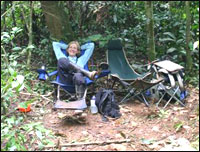
Sue settles in for some macaw-watching.
Photo: Christopher Jonas.
The name of the game on this job is “never take your eyes off of the nest.” One person is to look at the nest at all times so we can record faithfully all the comings and goings (ins and outs) of the parent macaws as they visit their chick, as well as numerous other events such as adults or chicks looking out of the nest (our chick is too young, thankfully), predators in the area, and, always, the weather.
We settle in to reclining canvas chairs, wondering how on earth we’ll be able to record anything that happens, given that the nest is 180 feet away and 60 feet up in a huge Dipteryx tree. Although only one of us is required to look at the nest at any given moment, we both stare diligently at the distant hole, fearful of missing an in or out. My arm muscles are already screaming from holding up my binoculars.
But I also find it suddenly hysterical: Two large mammals staring up at a large piece of PVC pipe, 60 feet up a tree. Of this, scientific research is made?
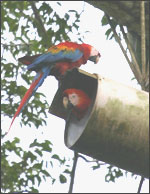
Two macaws settle in for some Sue-watching from their PVC nest.
Photo: Christopher Jonas.
Yes, the nest we are observing is an artificial one, in this case made of PVC pipe, but sometimes the artificial nests are wooden. The Tambopata Macaw Project, under the direction of Donald Brightsmith, is experimenting with placing artificial nests high up in the trees. The hope is to perfect artificial nests here where the population is large enough to be healthy. Then the approach can be transferred to areas where the population is more fragile. One of the key threats to macaws in the Amazon is the removal, by selective logging, of the giant, old-growth trees where they typically nest.
And it appears to be working. The nests are inhabited at approximately the same rate as natural nests. Although in the PVC nests fewer eggs hatch than in the natural nests, the same percentage of chicks survive.
The other focus of the nest project is determining what goes on in macaw nests, both natural and artificial. That’s where we come in. With the help of Earthwatch volunteers, an extensive amount of data on the natural history and behavior of nesting macaws is being collected.
Over the course of the next several hours, we settle into the task. I figure out that I can, in fact, monitor nest activity without my binoculars — though when something does happen, I greedily grab them. A group of climbers arrives at our nest. Climbers are longer-term volunteers who climb to the nest and lower the chicks to volunteers below, who weigh and measure them. In some cases, early in the nesting season, they also feed the chicks.
The feeding is part of another project goal: finding ways to improve the survival rate. For reasons that are poorly understood, in macaw broods of two chicks, the second chick very often dies of starvation. In broods of three, the third virtually always does. Even so, here in southeastern Peru, the macaw population is large enough and lives long enough to sustain itself.
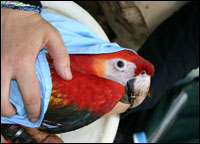
Measuring a macaw chick.
Photo: Christopher Jonas.
However, in areas where the population is endangered, techniques that improve survival by second chicks could be valuable. In the early 1990s, second chicks on the verge of death were removed from their nests and fed and incubated in the research center. The result are called chicos, birds that now live and nest in the wild but often hang around the lodge. They are charming, but this is perhaps not the best approach to increasing a wild population.
So now the starving birds are fed once or twice a day in the nest. The researchers have found that after a week or two of this, the parents begin feeding the chicks again.
It is an interesting sport, nest observation, but one with the pace of a cricket game. Long periods of no activity are punctuated by flurries of excitement. The end of our shift, 5:30, seemed a long way off when black clouds began to roll in and the wind picked up.
It’s been raining on and off all day and the river is quite high from rain in the Andes. We hear Brightsmith checking to make sure all the climbers are down because a storm is coming. Soon, thunder and lightning are crashing about us and, though we dutifully focus on the nest, our macaws appear to be hunkered down for the duration.
We aren’t sorry when our guide, Hans, appears at 4:30 and tells us we must leave because the water is rising in the forest. We slog back on paths that are now inches deep in water, appreciating the tall rubber boots that are part of the TRC uniform.
The river is very high, flooding the tree-lined bank. All through dinner and into the evening, we hear the crash of trees falling into the water, leaving me with a tremendous sense of what a dynamic ecosystem I am visiting.
Friday, 5 Mar 2004
PUERTO MALDONADO, Peru
Life as an Earthwatch volunteer is starting to settle into a routine.
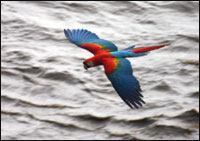
Macaw in flight.
Photo: Christopher Jonas
I work either in the morning (5:30 to 11:30) or the afternoon (11:30 to 5:30), either counting birds on the clay lick or observing scarlet macaw nests. In the morning or afternoon, when we are not working, the guides organize walks on the various forest trails — they are excellent at spotting wildlife and have great knowledge of the forest ecosystem.
From 5:30 until 7:00 we have social hour, facilitated by beer and pisco sours. Then we have dinner, followed by a talk on an aspect of the research conducted at TRC or a night walk in the forest. Then we are off to bed about 9:00 in order to start again at 4:30 a.m. the next day.
I can see how my second (and last) week will both move laconically — the days running together — and seem like it went quickly when it is over. The culture of TRC is friendly and relaxed. This week it is inhabited by our group of 13 from Earthwatch, a handful of longer-term volunteers and other members of the research project, the capable and friendly lodge staff, an entomologist from Lima, a few tourists, and, of late, a British film crew making a documentary about the jungle.
One hears many discussions of the nests and everyone is generally aware of how many birds visit the clay lick on a given day. Our Earthwatch group spends a great deal of time describing our various wildlife sightings, trotting them out like baseball cards, poring over digital images on tiny camera screens.
On nights when it isn’t raining, the entomologist sets up an electric bulb in front of a sheet outside the lodge. In no time, the sheet is covered with a huge variety of moths, beetles, cicadas, and other insect life. The entomologist is interested in a particular sort of beetle and he collects those from the sheet. Meanwhile, the research staff and other people run around gasping at various specimens and taking them over to nearby trees where they can photograph them au natural. A couple nights ago I asked Don if he thought that some of the bugs on the sheet were undocumented species. He translated my question to Juan, the entomologist, who was standing nearby.
“Claro,” he replied without hesitation. Of course. What a place!
Although we are busy, life is calm and focused and I am already beginning to reflect on the questions I was posing on the plane here. I wondered how the partnership between the researchers and the native community was working as a strategy (one I believe is necessary) for conservation. Clearly something quite impressive is going on.
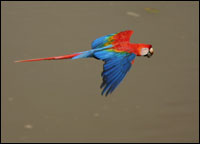
Macaw-some.
Photo: Christopher Jonas.
A Peruvian company, Rainforest Expeditions, is running two eco-lodges, one in partnership with the native community. The other houses a research facility to which they contribute space and funding. The research team, led by Donald Brightsmith (who is both research director for Rainforest Expeditions and a research associate with Duke University), integrates scientists from the U.S. and Peru as well as volunteers and staff from the local community, elsewhere in Peru, and the U.S. Based on my first week here, it appears to me to integrate them quite seamlessly. I saw the bartender looking at the list of nests in the dining room and discussing them with a guide and a Peruvian veterinarian.
Secondly, I hoped to understand the significance of the research I would be involved in. After a week here, I am still wondering about the value, from an environmental perspective, of focusing on a single species — in this case, one that is neither threatened nor endangered, at least not here. And though parrots and macaws are incredibly beautiful birds, they are not a keystone of the ecosystem. They are seed predators, not dispersers; they are not even a regular dinner for anyone.
However, they are a flagship species. They are the kind of species that, with their charm, can save entire ecosystems. Here, they form the basis of an impressive ecotourism partnership with the native community. And I remember that the parrot family, psittacidae, is one of the most endangered families of birds in the world. The techniques being learned on macaws here could be used to save other parrot populations throughout the tropics.
Finally, and perhaps most interesting to me, data are being gathered that illuminate the interaction of a species with its environment — from the types of seeds it feeds on to the role of the clay lick where it spends so much time to its nesting requirements. As Don likes to say, each of these are pieces of the puzzle. When it is all put together, it seems to me, it will help us with larger questions of rainforest ecology and bird behavior.
I also wondered how I would react to the lifestyle of field research. After a week, I am finding TRC a wonderful place for a somewhat extended sojourn. It combines extensive time in the rainforest (hours just sitting and observing) with a learning environment. Certainly we are learning about macaws, through nightly presentations of the research and dinner conversations with the principal investigator (PI). It feels like we are doing real work here and are respected as such. The people here, from the PI to the guides to the biologist volunteers, all love the rainforest and are glad to explain things to whomever will listen. And as a group, the Earthwatch volunteers are feeling more and more a team as we share our life stories while staring at nests.
But most importantly, I’m getting the opportunity to settle in and really acclimate to the rainforest, to begin recognizing plants and bird sounds, even if I cannot name them.
Seeing macaws in flight is a glorious thing — and you see it all the time. And knowing that just in this region of Peru, Madre del Dios, the amount of protected rainforest is equal to the entire country of Costa Rica is incredibly cheering.
Two tourists arrived here today. Because of the rainstorm and the condition of the river yesterday, they had to spend last night at the checkpoint along the way. Instead of the two nights they had planned to spend here, they have one. They are making a yeoman’s effort to see it all. They took a hike this afternoon and a night hike this evening. Tomorrow morning, they will get up early and go to the clay lick and then they’ll be off. Been there; done that.
Today, though, I’m really glad that’s not me. I’m glad I’ll be here to see the river go down and whatever it holds in store next week.


